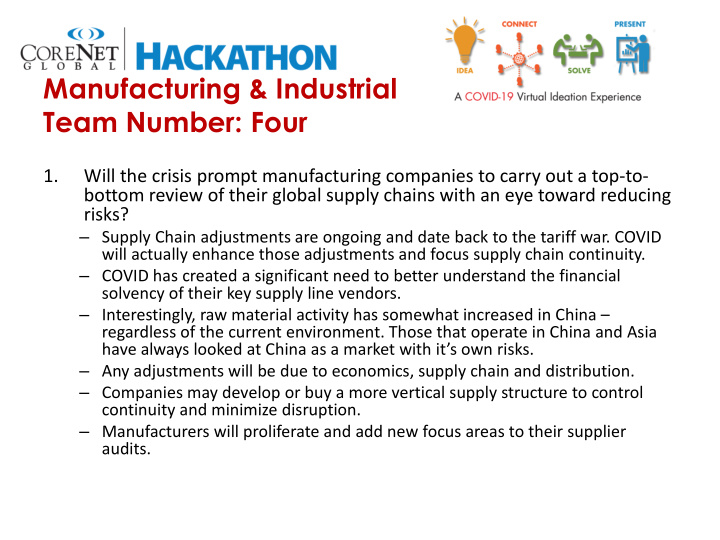



Manufacturing & Industrial Team Number: Four 1. Will the crisis prompt manufacturing companies to carry out a top-to- bottom review of their global supply chains with an eye toward reducing risks? – Supply Chain adjustments are ongoing and date back to the tariff war. COVID will actually enhance those adjustments and focus supply chain continuity. – COVID has created a significant need to better understand the financial solvency of their key supply line vendors. – Interestingly, raw material activity has somewhat increased in China – regardless of the current environment. Those that operate in China and Asia have always looked at China as a market with it’s own risks. – Any adjustments will be due to economics, supply chain and distribution. – Companies may develop or buy a more vertical supply structure to control continuity and minimize disruption. – Manufacturers will proliferate and add new focus areas to their supplier audits.
2. Will manufacturing return to areas that lost factories to lower-cost production sites? – Potentially, depending on labor availability and the specific industry. – COVID could have the reverse effect causing more companies to invest in automation to have full control of their process. – Automation will require the right facilities and an educated workforce. – In general, China is no longer cheap and hasn’t been. Those that manufacture in China have specific reasons and have known the risks. – Manufacturing investment will reduce in locations that have not demonstrated sufficient health care infrastructure, the ability to maintain worker safety and protect corporate assets.
3. Will regulatory and competitive environments shift, opening up new production opportunities in countries that have been off the radar? – NAFTA countries most certainly will be examined more closely. Mexico still has political instability and Canada has a higher cost of labor but each will be of greater interest. – Foreign countries will continue to “recruit” US based companies and this most certainly will include some “off the radar” countries. 4. Will countries and locations with better overall pandemic readiness make the shortlist for the next new factory, even if they’re less competitive on costs? - Cost and risk have always been key in factory site selection. Due to COVID, risk will now likely be weighed even greater than in the past. - South Korea for example has only enhanced their potential for new projects due to their strong pandemic readiness.
5. Will governments begin to offer new financial incentives to attract industrial jobs and investments as they see opportunities to capture projects that might have previously gone offshore and enable a more stable, controllable supply chain? – Governments, including state governments in the US and foreign governments, have recruited companies with financial incentives for decades. – Incentives will need to encompass the full spectrum of real estate development (real estate tax, employee tax, low or free rent, etc.) to offset potential risk issues.
• FINAL THOUGHTS – – What is the United States’ threshold of pain for stockpiling the essentials and what is the new acceptable risk? That will dictate reshoring. – There is a strong belief that firms will begin controlling the risk of their supply chain exposure by investing in automation. – A few main points: • 1. There will not be a wholesale change that occurs in the supply chain process. All of this is industry specific. • 2. There will be a quick onshoring of pharmaceuticals • 3. Supply chains will be scrutinized now more than ever with a new focus on audits of suppliers and customers.
Recommend
More recommend